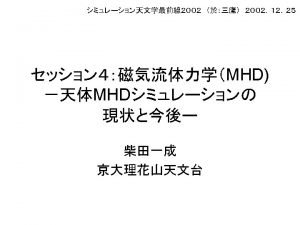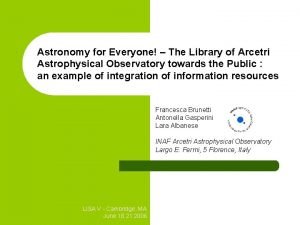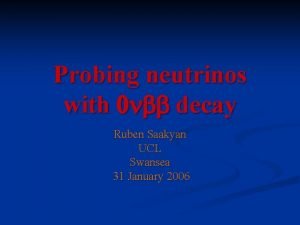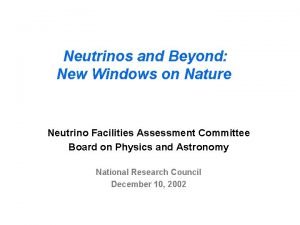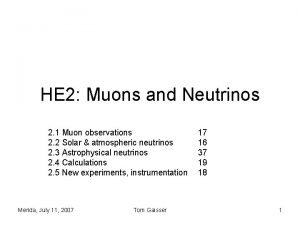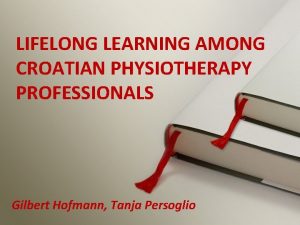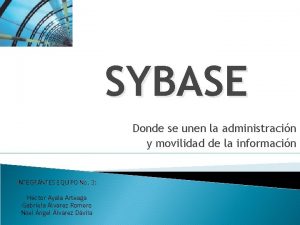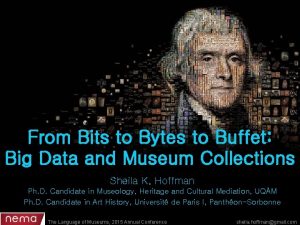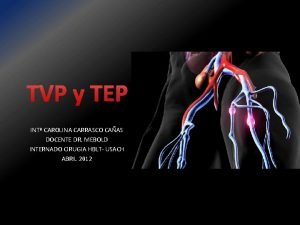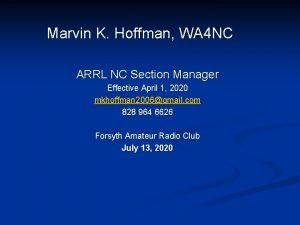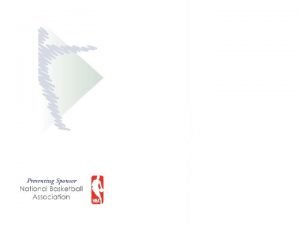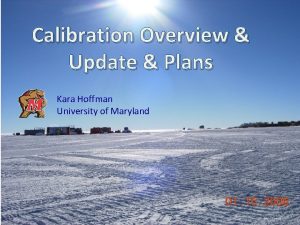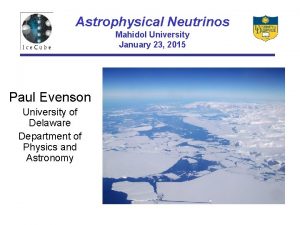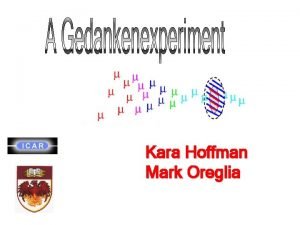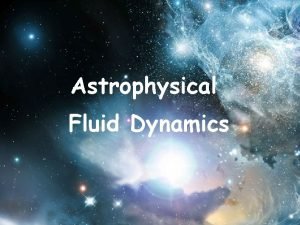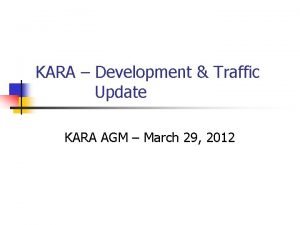Nu 6 Astrophysical Neutrinos Conveners Kara Hoffman University


















- Slides: 18

Nu 6 Astrophysical Neutrinos �Conveners: Kara Hoffman, University of Maryland Cecilia Lunardini, Arizona State University Nikolai Tolich, University of Washington

Neutrinos in the early Universe � Neutrinos contribute to cosmic radiation Data from cosmic microwave background and relic abundance of light elements: compatible with Standard Model Extra radiation allowed/favored: room for sterile neutrinos Krauss, Lunardini & Smith, ar. Xiv: 1009. 4666

� Neutrinos contribute to dark matter Light mass dampens structures at small scales Reaching ~ 0. 1 e. V sensitivity would probe the mass hierarchy Jimenez et al. , JCAP 1005: 035, 2010

�Cosmological data can probe new neutrino physics New interactions, new properties �The “Holy Grail”: is the direct detection of relic neutrinos possible? Prototypes are exploring zero-threshold inverse beta decay

Solar neutrinos � Answers to the following questions could change our understanding of the formation of the Solar System and the evolution of the Sun: what is the total solar luminosity in neutrinos? 1. ▪ Requires precise measurements of pp or pep neutrinos what is the metallicity of the Sun’s core? 2. ▪ Possible with precise measurements of CNO neutrinos � Ideal probe for studying neutrino oscillations Precise measurements of pep neutrinos would be very sensitive to nonstandard physics. An observation of a day-versus-night difference would conclusively demonstrate the so-called MSW effect.

Geoneutrinos � Measurements of the geoneutrino flux will determine the amount of heat-producing elements in the earth, which is currently only estimated through indirect means. � Kam. LAND and Borexino measurements have already ruled out some earth models. � More detectors are required to disentangle local variations Ideally with some on the ocean floor to measure the mantle contribution.

Supernova neutrinos � Supernovae play a key role in the history of the universe and in shaping our world. � Supernova neutrinos record information about processes in the center of the explosion, allowing us to study the equation of state of the nuclear/quark matter in extreme conditions. � Supernovae provide a source for understanding neutrino interactions and oscillations in regimes inaccessible on Earth. � Supernova in our galaxy are relatively rare (1 -3 per century) � To maximize physics from a burst, flavor sensitivity and time evolution are critical. � The flux of neutrinos from all supernovae in cosmic history (DSNB) yields more limited, but complementary, information.

Liquid scintillator detectors � Low background liquid scintillator detectors like Borexino and SNO+ are sensitive to solar neutrinos from the pep reaction and the CNO cycle. � The proposed LENS experiment would precisely measure the entire solar neutrino energy spectrum. � Liquid scintillator detectors are the only existing or proposed geoneutrino detectors. � Liquid scintillator detectors are sensitive to supernova neutrinos, primarily electron anti-neutrinos through neutron inverse beta decay, but also non-electron neutrinos through proton scattering provided their thresholds are low enough. � Large enough detectors could measure the DSNB.

Cherenkov detectors � The Super. K and SNO experiments have measured the 8 B solar neutrinos flux and neutrino oscillations to better than 5%. � The proposed Hyper. K detector would measure the solar neutrino day versus night asymmetry with a significance better than 4σ. � Hyper-K would observe ∼ 250, 000 interactions from a core collapse supernova at the galactic center, allowing for very sensitive study of the time evolution of the neutrino signal. � The addition of Gd to the Super-K or Hyper-K detectors would allow for the study of DSNB within the range of most predictions for the total flux.

Liquid argon detectors � Unlike other supernova detectors, which are primarily sensitive to anti-electron neutrinos, the principle signal in a liquid argon detector would be due to electron neutrino interactions. � For a supernova at 10 kpc approximately 1000 events would be expected per 10 kton of liquid argon. � Critical to site detector underground.

Low energy expt summary Type Exp. Loc. Size (kton) Status Solar Geo SN Scint. Borexino Italy 0. 3 Oper. ** ** * Scint. Kam. LAND Japan 1 Oper. ** ** * Scint. SNO+ Canada 0. 8 Cons. ** ** * Scint. RENO-50 South Korea 10 R&D * * ** Scint. JUNO China 20 R&D * * ** Scint. Hanohano TBD (USA) 20 R&D * ** ** Scint. LENA TBD (Europe) 50 R&D * ** ** Scint. LENS USA 0. 12 R&D ** * Cher. Super. K Japan 50 Oper. ** ** Cher. Ice. Cube S. pole 2000 Oper. Cher. Hyper. K Japan 990 R&D ** ** LAr LBNE USA 35 R&D * ** **

High Energy Neutrino Telescopes �The first kilometer scale neutrino telescope is now taking data, with new facilities planned

Highest energy neutrinos ever observed! �Ice. Cube has seen events in excess of a Pe. V

An astrophysical flux? • • Flavor composition Energy spectrum Zenith distribution No accompanying air showers All incompatible with background. >4 s effect…. so far Compatible with an approx. E-2 spectrum with an apparent cutoff around 10 Pe. V

Implications of an astrophysical flux �Still no source identified �Needs more data/observation �Ice. Cube would expect ~100 events in 10 years �Flavor composition interesting for both particle physics and astrophysics �Could benefit form a low density Ice. Cube extension or an air shower veto extension

Niche for Neutrino Telescopes in Particle Physics Neutrino Telescopes are generally proving to be general purpose facilities, with infill arrays extending sensitivities to indirect dark matter searches, as well as allowing neutrino oscillation analyses ICECUBE/DEEP CORE DARK MATTER SEARCHES- WIMP annihilations in the Sun M. G. Aartsen et al. , Phys. Rev. Lett. 110 (2013) 131302. NEUTRINO MASS HIERARCHY WITH PINGU Ar. Xiv: 1306. 5846

Askaryan Arrays detection of RF impulses from neutrino interactions • Several UHE neutrino telescopes with sensitivity to GZK fluxes are in the prototyping/feasibility phase. ARIANNA EVA

Sensitivity of Next Generation GZK neutrino telescopes • Is this the steepening in the cosmic ray spectrum caused by interactions on the CMB, or are accelerators just running out of steam? • What is the compositions of cosmic rays? • Next generation UHE telescopes expected to have sensitivity to the GZK neutrino flux.
 Astrophysical journal keywords
Astrophysical journal keywords Arcetri astrophysical observatory
Arcetri astrophysical observatory Neutrinos
Neutrinos Neutrinos
Neutrinos Neutrinos
Neutrinos Felix hoffman aspirin
Felix hoffman aspirin Hofmann eliminasyonu
Hofmann eliminasyonu Hoffman gilbert
Hoffman gilbert Biceps refleksi
Biceps refleksi Dustin hoffman laurence olivier
Dustin hoffman laurence olivier Sybase caracteristicas
Sybase caracteristicas Chloe hoffman
Chloe hoffman Otto hoffman's by product oven
Otto hoffman's by product oven Sheila hoffman phd
Sheila hoffman phd Valor normal de dímero d
Valor normal de dímero d Marvin hoffman
Marvin hoffman Hans christian andersen bibliografia
Hans christian andersen bibliografia Mark hoffman auburn
Mark hoffman auburn Unit 5 meeting individual care and support needs assignment
Unit 5 meeting individual care and support needs assignment
